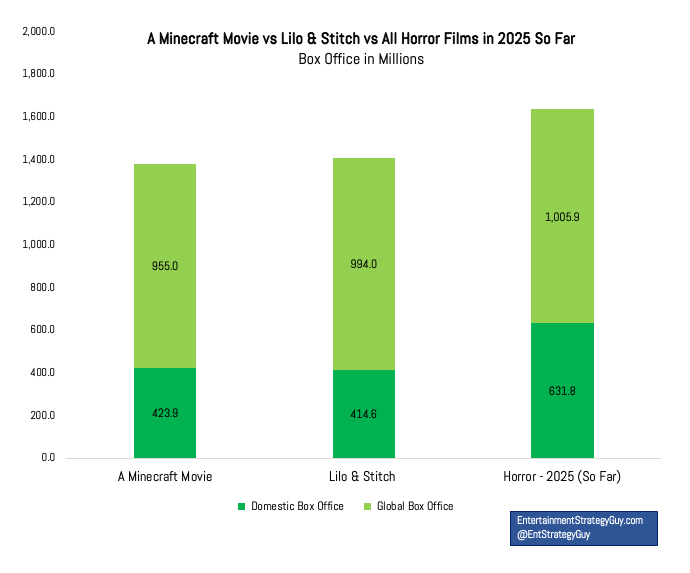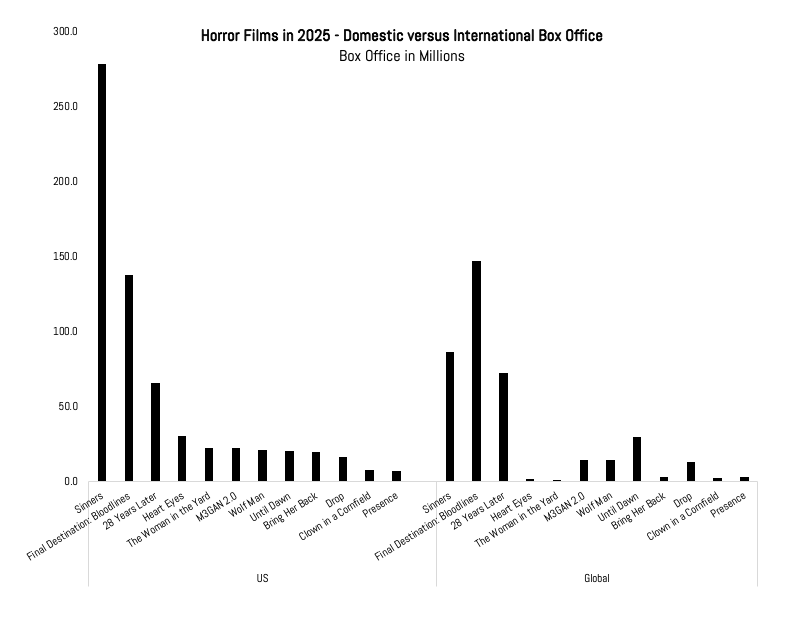Here’s how you can create disagreement online:
Just talk past the other person.
It’s that easy!
For example, I constantly read articles about how “horror is the most bankable film genre”, but I almost never read articles about animated or family films being “the most bankable genre”, when, clearly, they are the most bankable genre. How can both articles be right at the same time?
Well, it begs the question, “What do you mean by ‘bankable’?”
That’s what I’m going to explore today, while updating my (now annual) comparison between horror and animated/family films. (Stay tuned, horror fans, there’s good news ahead.)
When it comes to feature films, one could actually define success in a few ways. I’ve boiled it down to five, reminiscent of basketball’s “four factors” or The Goal’s three metrics.
Let’s start with the first three factors:
For example, if you’re a movie theater owner, you don’t really care if a small horror film has a great ROI if you don’t sell enough seats overall to keep your lights on. You care about overall revenue/demand. But if you’re an independent producer, you just want to get a big return on investment on your films.
Let me illustrate this. Clown in a Cornfield made $7 million in the US off a $1 million budget. Great! That’s a good ROI. But The Minecraft Movie made $423 million. While the producers of Clown in a Cornfield made $3.5 million, so did movie theater owners. But those theater owners made $211.5 million off of The Minecraft Movie, or sixty times Clown in a Cornfield. If you own a movie theater, you need more movies like The Minecraft Movie to survive.
Those are three metrics to look at individual or film slate success. But when we’re debating or analyzing movie “genres”, two more factors come into play:
Often, when I read box office coverage, I notice that people (including me) interchange all these terms, and often when folks disagree with each other, they’re just talking about different metrics.
So here’s the big visual of the week, two family films versus an entire genre:
Here’s the “Data 5W’s” for this chart:
This chart perfectly illustrates what I’m talking about. For theater owners, two films, by themselves, generated nearly as many sales as the buzziest genre (horror) in filmmaking.
Right now, blockbuster family films are keeping the lights on for theater owners.1 But not only are hit animated films absolutely huge, their hit rate is elite, especially sequels or movies based on popular IP animated features. In 2023 and 2024, the animated genre only had two misses. That’s insane. (I should clarify, for films with wide theatrical releases. Smaller, independent animated films struggle to stand out.)
Interestingly…
Horror films did way, way better compared to the last time we did this exercise.
Last year, I compared animated films to the entire horror genre, and Inside Out 2 beat it. This year, the biggest film and the horror genre essentially tied. (Also, the time frame is much shorter, just six months instead of nine months.)
What matters is why this fight is so much closer this year...
So far in 2025, the horror genre has delivered some big hits and great ROI. Not only have ten films grossed over $19 million so far this year, Sinners grossed $278 million in the US, Final Destination: Bloodlines grossed $137 million, and 28 Years Later grossed $63 million.
When I wrote about how Inside Out 2 made more than all horror films combined, the main point I was trying to make was that horror, as a genre, needed to deliver more big hits—to cite the four factors, horror needed to raise its ceiling and increase its total revenue—and this year, they had three big hits and one genuine blockbuster (over $250 million).2 And the genre still has some big swings coming for the rest of the year, like the reboot of I Know What You Did Last Summer, The Black Phone 2, The Conjuring: Last Rites, and Five Nights at Freddy’s 2, of course.














